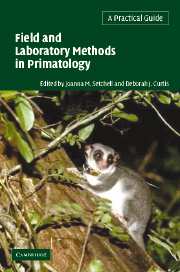Book contents
- Frontmatter
- Contents
- List of contributors
- Forword by Robert D. Martin
- Introduction
- 1 Human-nonhuman primate interactions: an ethnoprimatological approach
- 2 Habituating primates: processes, techniques, variables and ethics
- 3 Habitat description and phenology
- 4 The Global Positioning System, Geographical Information Systems and Remote Sensing
- 5 Monitoring local weather and climate
- 6 Survey and census methods: population distribution and density
- 7 Trapping primates
- 8 Handling, anaesthesia, health evaluation and biological sampling
- 9 Morphology, morphometrics and taxonomy
- 10 Marking and radio-tracking primates
- 11 Feeding ecology and seed dispersal
- 12 Dietary analysis I: Food physics
- 13 Dietary analysis II: Food chemistry
- 14 Collecting arthropods and arthropod remains for primate studies
- 15 Tape-recording primate vocalisations
- 16 Photography and video for field researchers
- 17 Chronobiological aspects of primate research
- 18 Thermoregulation and energetics
- 19 Field endocrinology: monitoring hormonal changes in free-ranging primates
- 20 Collection, storage and analysis of non-invasive genetic material in primate biology
- 21 Tips from the bush: an A-Z of suggestions for successful fieldwork
- Index
- References
7 - Trapping primates
Published online by Cambridge University Press: 05 June 2012
- Frontmatter
- Contents
- List of contributors
- Forword by Robert D. Martin
- Introduction
- 1 Human-nonhuman primate interactions: an ethnoprimatological approach
- 2 Habituating primates: processes, techniques, variables and ethics
- 3 Habitat description and phenology
- 4 The Global Positioning System, Geographical Information Systems and Remote Sensing
- 5 Monitoring local weather and climate
- 6 Survey and census methods: population distribution and density
- 7 Trapping primates
- 8 Handling, anaesthesia, health evaluation and biological sampling
- 9 Morphology, morphometrics and taxonomy
- 10 Marking and radio-tracking primates
- 11 Feeding ecology and seed dispersal
- 12 Dietary analysis I: Food physics
- 13 Dietary analysis II: Food chemistry
- 14 Collecting arthropods and arthropod remains for primate studies
- 15 Tape-recording primate vocalisations
- 16 Photography and video for field researchers
- 17 Chronobiological aspects of primate research
- 18 Thermoregulation and energetics
- 19 Field endocrinology: monitoring hormonal changes in free-ranging primates
- 20 Collection, storage and analysis of non-invasive genetic material in primate biology
- 21 Tips from the bush: an A-Z of suggestions for successful fieldwork
- Index
- References
Summary
INTRODUCTION
There are many reasons to capture your study animals, including marking or radio-collaring individuals (Chapter 10), taking morphological measurements (Chapter 9) and biological sampling (Chapters 1 and 8). For small nocturnal primates, trapping may be the only way to gather data for density estimates (Chapter 6). Furthermore, it is essential for the determination of spatial distribution and social interactions of individuals, as the most effective method uses direct observation of radio-tagged animals (Sterling et al., 2000). Historically, studies in which wild, larger-bodied non-human primates (hereafter called primates in this chapter) are habituated for long-term observation have rarely included capture, perhaps because researchers have been understandably wary of its effects on subsequent behaviour and habituation. However, our survey (Jolly & Phillips-Conroy, 1993; C. J. Jolly and J. E. Phillips-Conroy, unpublished data) of more than 120 studies that combined observation with capture, and which involved about 65 primate species, showed that a careful capture–release programme using trapping will not cause a previously habituated population to change its behaviour towards human observers, and will not be associated with excess mortality or serious injury. Changes in ranging habits caused by baiting and trapping will be temporary at worst, and basic social organisation and structure will not be affected. The survey also showed that trapping has been used most often to catch diurnal–terrestrial and nocturnal–arboreal species. Diurnal–arboreal primates (apart from callitrichines) have generally been captured by darting (Chapter 8), a bias that seems unjustified.
Information
- Type
- Chapter
- Information
- Field and Laboratory Methods in PrimatologyA Practical Guide, pp. 110 - 121Publisher: Cambridge University PressPrint publication year: 2003
References
Accessibility standard: Unknown
Why this information is here
This section outlines the accessibility features of this content - including support for screen readers, full keyboard navigation and high-contrast display options. This may not be relevant for you.Accessibility Information
- 11
- Cited by
